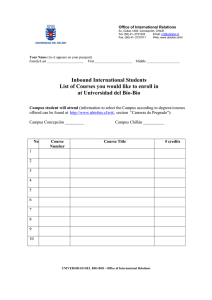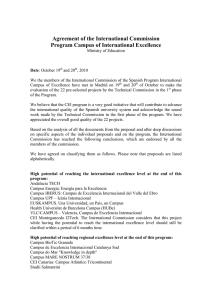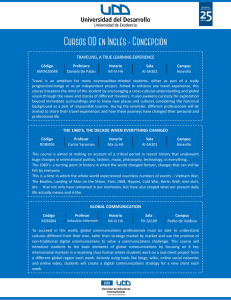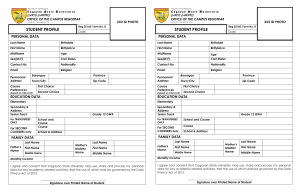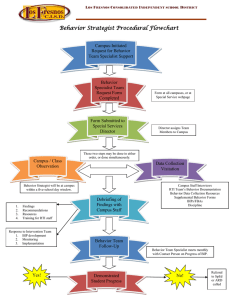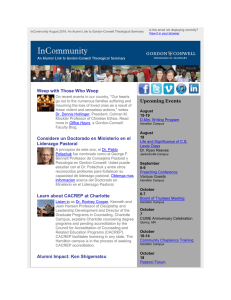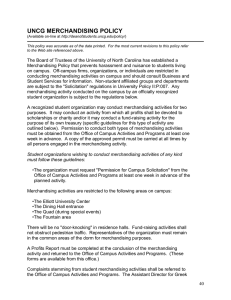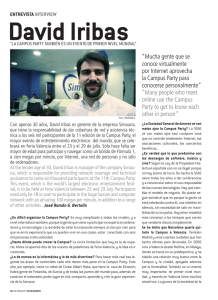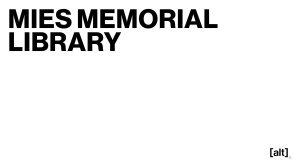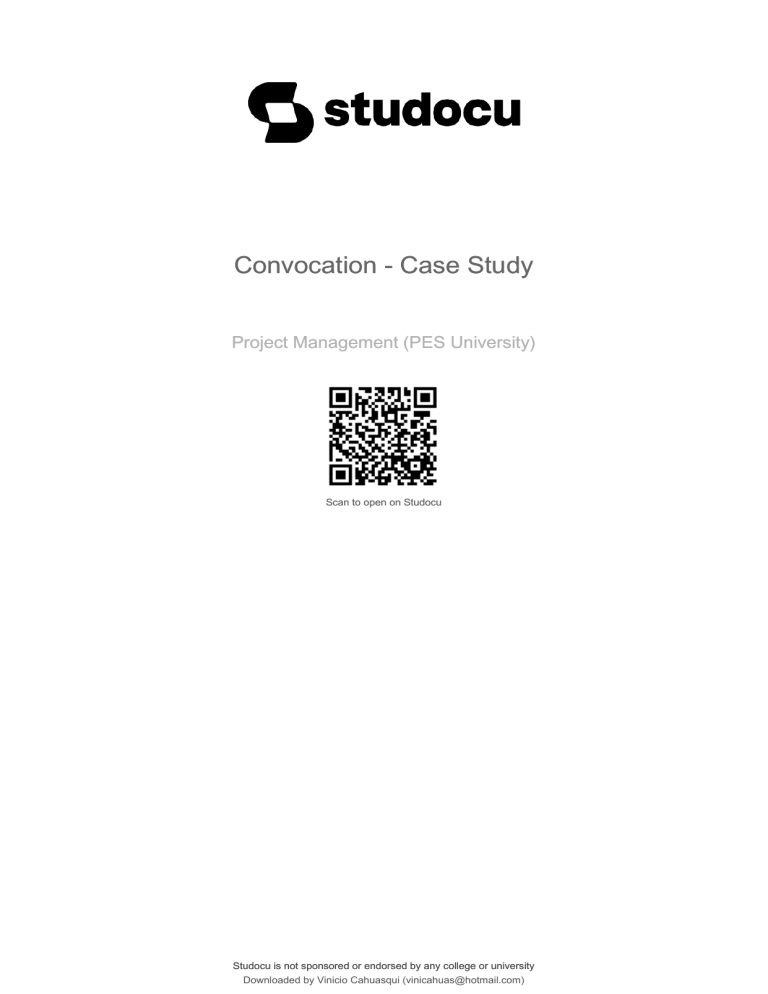
lOMoARcPSD|46725172 Convocation - Case Study Project Management (PES University) Scan to open on Studocu Studocu is not sponsored or endorsed by any college or university Downloaded by Vinicio Cahuasqui (vinicahuas@hotmail.com) lOMoARcPSD|46725172 rP os t H W13039 CONVOCATION AT THE NATIONAL INSTITUTE OF MANAGEMENT’S CENTRAL INDIA CAMPUS (A) op yo Professors S. Maheswaran, Jitendra Sharma and John Haywood-Farmer wrote this case solely to provide material for class discussion. The authors do not intend to illustrate either effective or ineffective handling of a managerial situation. The authors might have disguised certain names and other identifying information to protect confidentiality. Richard Ivey School of Business Foundation prohibits any form of reproduction, storage or transmittal of this material without its written permission. Reproduction of this material is not covered under authorization by any reproduction rights organization. To order copies or request permission to reproduce materials, contact Ivey Publishing, Richard Ivey School of Business Foundation, c/o Richard Ivey School of Business, The University of Western Ontario, London, Ontario, Canada, N6A 3K7; phone (519) 661-3208; fax (519) 661-3882; e-mail cases@ivey.uwo.ca. Copyright © 2013, Richard Ivey School of Business Foundation Version: 2013-02-22 tC Srinivas Mahesh served as the chairperson of the post-graduate diploma in management (PGDM) programs at the Central India campus of the National Institute of Management (NIM) outside of Nagpur, India. On Friday, December 31, 2010, Mahesh sat in his office, trying to decide how best to organize the information he and his team had collected on the operational details of NIM’s upcoming convocation ceremony, which, in other years, had always been held at the school’s Delhi campus in the National Capital Region (NCR). No Eleven days earlier, the school’s director, Raja Deshpande, had announced that NIM’s Central India campus would hold its own convocation on March 12, 2011, and that Mahesh would be in charge. Since then, with help from many other faculty members and some staff, Mahesh had gathered a considerable amount of information, and he now wondered what to do with it. A number of questions nagged at him. Would the team be able to pull it off? Where should Mahesh focus most of his attention over the next two months? How could he best use his time during the coming weekend to organize a roadmap for moving forward with the project? THE NATIONAL INSTITUTE OF MANAGEMENT Do NIM was established in 1981 when its first autonomous management school began offering post-graduate management programs in Delhi, in India’s NCR. Since 1995, NIM had consistently ranked among India’s top 10 business schools. In 2004, the NIM group opened its Central India campus near Nagpur, a city of some 2.4 million people near the geographic centre of the country in eastern Maharashtra State, some 1,000 kilometres south of Delhi. NIM later opened a campus in Dubai and another in Hyderabad, about 550 kilometres south of Nagpur. By the end of 2010, NIM was one of the few well-known institutions in India to have four campuses, including one abroad. The four NIM campuses operated more or less independently within an overarching vision. This document is authorized for educator review use only by Gopal Krishna Sharma, Dayananda Sagar College of Engineering until Oct 2023. Copying or posting is an infringement of copyright. Permissions@hbsp.harvard.edu or 617.783.7860 Downloaded by Vinicio Cahuasqui (vinicahuas@hotmail.com) lOMoARcPSD|46725172 9B13D003 rP os t Page 2 In 2009, NIM’s Central India campus had admitted about 360 students. Attrition reduced that number to about 260 by graduation at the end of the programs in 2011. As the campus director, Deshpande was a member of NIM’s managing committee and possessed line authority over the approximately 50 faculty and 100 staff on the campus (see Exhibit 1.) Reporting to the director was the dean, Arvind Tandon. The 48 faculty were organized in a classic matrix organization. The dean had functional authority over faculty and academic staff members; the faculty in each of the nine academic areas (marketing, operations, business analytics, etc.) reported to the dean through an area chairperson on functional matters and to the director on all other matters. A number of faculty members not only taught and did research but also served in an administrative capacity; Mahesh (chairperson of PGDM programs) was one example. op yo CONVOCATION: THE EVENT OF THE YEAR tC Convocation stood out as one of the most important and celebrated events in a student’s life. A postgraduate program was the final leg in the formal education of many students. All students, as well as their families, looked forward to this event as a milestone that represented one of their greatest achievements. NIM always made every effort to ensure that its convocations were memorable. The school invariably invited one of the country’s top business leaders to deliver the convocation address, and, in the past, business luminaries such as the senior executives of Infosys, Mahindra and Mahindra, Kingfisher, Tata Sons, Reliance Industries and Airtel had performed this role. Traditionally, NIM had always held a single joint convocation for its graduating students at the NCR campus, with graduating students and faculty from the Central India campus travelling to the NCR campus to attend the event, which usually took place during the second week of March each year. The role of the faculty from the Central India campus was simply to be part of the occasion. More than 3,000 people, including graduating students and their families, attended the NIM convocation every year. Because NIM’s Hyderabad campus had begun operations in 2010, its first batch of students was not yet ready to graduate. THE NIM CONVOCATION IN NAGPUR No The story began on Monday, December 20, 2010, a typical winter morning. Mahesh, a faculty member who taught operations, arrived at his office and, as usual, logged on to his computer and began checking his e-mail. Among the messages was one from Deshpande with the subject line “Faculty Meeting — Convocation 2011” scheduled for 11 a.m. that day. Given the history of NIM convocations, Mahesh was puzzled and understandably curious; he had no idea why Deshpande had called the meeting. Do When the meeting began, Deshpande wasted no time in getting to the point. He announced that the convocation ceremony for the Central India campus’s graduating class for the current year would be held on Saturday, March 12, 2011, and, more importantly, that it would be held in Nagpur rather than in the NCR. Taken aback by the announcement, some faculty members questioned the rationale behind the decision as well as the institution’s ability to handle an event of that magnitude at such short notice. In response, Deshpande defended and justified the management’s stand and emphasized that the decision was final. In his own inimitable manner, he urged everyone not to waste time discussing the decision and exhorted them instead to focus on the critical question now before them: How would they execute this impending event? Deshpande then announced that, as was the custom at the parent institution, the campus’s program chairperson — in this case, Mahesh — would serve as the event co-ordinator. With a formal announcement, he asked Mahesh to take over the management of the event and then abruptly ended the This document is authorized for educator review use only by Gopal Krishna Sharma, Dayananda Sagar College of Engineering until Oct 2023. Copying or posting is an infringement of copyright. Permissions@hbsp.harvard.edu or 617.783.7860 Downloaded by Vinicio Cahuasqui (vinicahuas@hotmail.com) lOMoARcPSD|46725172 9B13D003 rP os t Page 3 meeting. Mahesh’s earlier curiosity and excitement about the meeting were shattered by Deshpande’s bombshell announcement. He was distraught, to say the least. Mahesh’s Initial Thoughts op yo Although Mahesh had served as the program chairperson for two years, he had never given much thought to the logistics involved in conducting a major event such as convocation. His only role in the past had been to send a list of graduating students to the NCR campus. It would be an understatement to say that he was perturbed to hear the news at the meeting. Mahesh slept fitfully on the night after the announcement, with the magnitude of his new assignment weighing heavily on his mind. By morning, however, his mood had lifted. He concluded that his situation was an example of Hobson’s choice,1 so, with no alternative before him, he decided to give it his best shot. tC On entering his office, Mahesh skipped his usual routine of checking his e-mail, not having the stomach for more shocks or surprises like the one he had received yesterday. Instead, he set about earnestly pondering his new assignment. Mahesh quickly determined that convocation would occur in only 81 days, a number that immediately concerned him. How could a first-time event of that scale be planned and executed in the time available? Mahesh decided that the first order of business would be to create a list of the activities that would have to be carried out for the convocation. He knew that although some activities could be performed immediately, others could not begin until certain ones had first been completed. A list of these activities would serve as roadmap for the event; however, Mahesh would need the help and support of his colleagues in order to develop this comprehensive list. He decided to call a general body meeting of the faculty for the next day, Wednesday, December 22, with the aim of creating a roadmap for the convocation. The First General Body Meeting No Some 35 faculty members attended the first general body meeting; the remainder were unable to attend for a variety of reasons. The meeting began with some opening remarks from Deshpande, during which he made it clear that despite the reservations of some faculty members, the convocation date established by the management committee remained non-negotiable. He also said that all faculty would be expected to devote some time to making the event a success, even on weekends, for which they would be compensated by time off at a later date.2 Mahesh then raised the all-important issue of creating a roadmap for convocation, saying, “I called this meeting to discuss the various activities that need to be carried out for the convocation. I am asking all of you to actively participate in and contribute to this effort. We have to have everything done by March 11 at the absolute latest because there won’t be time that day to do anything except savour the moment.” Do The following section is an excerpt from the ensuing discussion; it raised more questions than answers and revealed the true nature of the challenge before them. Ram Gadge: 1 2 I jotted down a few points that may be useful. First, we need to confirm the chief guest. As we have only two months left, it may be very difficult for us to get an appointment from a hot-shot business tycoon. A person facing Hobson’s choice must take either what has been offered or nothing at all; in other words, there is no viable choice. It was common practice in India to restrict the Christmas break to one day. This document is authorized for educator review use only by Gopal Krishna Sharma, Dayananda Sagar College of Engineering until Oct 2023. Copying or posting is an infringement of copyright. Permissions@hbsp.harvard.edu or 617.783.7860 Downloaded by Vinicio Cahuasqui (vinicahuas@hotmail.com) lOMoARcPSD|46725172 9B13D003 rP os t Page 4 Raja Deshpande: As director, I can say that that will be taken care of by the management committee. We need not worry about it. In that case, we need to concentrate on securing contractors for the marquee and catering, finding a gown supplier, organizing accommodation for parents and so on. Sunil Sarin: We also need to promote the event by placing an advertisement in the papers and inviting the media to cover the event. Karan Chandak: Since it is a purely academic event, the advertisement needs to appear only on the day of the event. As for inviting the media, we need to visit the press bhavan (hall) and brief them about the event. op yo Ashish Dey: Raja Deshpande: Does anyone know who supplied the convocation gowns for the NCR campus convocation? Ashish Dey: As far as I know, they were procured in Delhi. I don’t think we have a similar supplier here. Raja Deshpande: Then we need to contact them in Delhi and find out whether they can supply gowns for us. There may be additional costs associated with that because of our distance from the capital. Ashish Dey: I think we first need to list the activities that have to be carried out and identify their sequence. Sanjay Shukla: tC Srinivas Mahesh: If I am not wrong, that’s what we are doing right now. I don’t think we will be able to identify all the activities now. We are just discussing the major activities. Also, there are a lot of minor activities that we need to identify, such as printing and distribution of invitation cards, arranging security, parking and ambulances, alerting the fire brigade, etc. No Raja Deshpande: When are we planning to declare the results of the final term as per the academic calendar? Srinivas Mahesh: The last final term exam will be written on February 25, and the marks will be communicated to students on March 3. Any discrepancies will be addressed shortly afterwards. On March 6, we will announce the final results. Do Raja Deshpande: In that case, we will need to advance this date. How else will we have the convocation diplomas and mark-sheets ready in time for the event on March 12? Vipin Handa: How can we advance the calendar without dropping some courses or sessions? Srinivas Mahesh: Perhaps we could reduce the number of sessions per course instead of reducing the number of courses. This document is authorized for educator review use only by Gopal Krishna Sharma, Dayananda Sagar College of Engineering until Oct 2023. Copying or posting is an infringement of copyright. Permissions@hbsp.harvard.edu or 617.783.7860 Downloaded by Vinicio Cahuasqui (vinicahuas@hotmail.com) lOMoARcPSD|46725172 9B13D003 rP os t Page 5 Raja Deshpande: That’s a good idea. If we reduce two sessions per course in the final term, by how many days will we be able to advance the results declaration date? Bunty Oberoi: We will be able to advance it by about 15 days. Arvind Tandon: Is it a good idea to reduce the sessions from 20 to 18 per course? What about the material that has to be covered in those two sessions? Raja Deshpande: Two sessions out of the 20 are earmarked for industry guests. Students have been getting this type of industry exposure from the beginning of the program, so I think we could give up this initiative, at least for this term. Agreed. Ashish Dey: My question has not yet been answered. op yo Arvind Tandon: Raja Deshpande: We are here not only to ask questions but also to find answers. Suresh Kumar: I think these minor activities may be taken care of at a later stage. Let us start working on the major activities and not waste time now. Vipin Handa: tC Raja Deshpande: No, lapses usually occur in minor activities and can put a blot on the whole event. I have a suggestion. As we have already spent more than two hours on this discussion and are still not able to figure out what all the relevant activities are, perhaps Srinivas [Mahesh] and a few other colleagues could make a trip to the NCR campus and meet the chief co-ordinator of last year’s convocation to get more details. That is a wonderful idea! I volunteer to go with Srinivas. No The meeting concluded with Mahesh stating that he would seek an appointment with Vipul Khurana, the program chairperson at the NCR campus, who had co-ordinated the previous year’s convocation ceremony, and convene a meeting to discuss the team’s findings on his return. Mahesh and Handa’s Trip to the NCR Campus Do Two days later, on Friday, December 24, Mahesh and Handa travelled to NIM’s parent campus to meet Khurana, the chief administrative officer, and Sharat Saxena, a former naval officer who had a greater passion for operations than administration. This visit was an eye-opener. Through their interactions with Khurana and Saxena, Mahesh and Handa discovered many new pieces of the puzzle and began to understand which activities were vital and which ones were trivial. The most valuable outcome of the meeting came in the form of acquiring a breakdown of the activities under different headings and the area of operations of each activity. Although they found there was overlap between some activities, the breakdown of operations gave them the opportunity to plan those activities more efficiently. This document is authorized for educator review use only by Gopal Krishna Sharma, Dayananda Sagar College of Engineering until Oct 2023. Copying or posting is an infringement of copyright. Permissions@hbsp.harvard.edu or 617.783.7860 Downloaded by Vinicio Cahuasqui (vinicahuas@hotmail.com) lOMoARcPSD|46725172 9B13D003 The Second General Body Meeting rP os t Page 6 op yo Mahesh and Handa returned to the Central India campus, armed with a lot of ammunition for discussion and deliberation. Mahesh called a second general body meeting for Monday, December 27, which was an all-staff meeting to which not only faculty but also non-teaching and support staff were invited. The discussion centred on Mahesh and Handa’s discoveries during their meeting with Khurana and Saxena and on the various activities involved in a formal convocation ceremony. Mahesh made a presentation and showed some video clips from the two previous convocations at NIM’s NCR campus for the benefit of those who had never been to such an event. Following the presentation, Deshpande suggested that Mahesh should list the various activities under different headings and assign each one to a committee comprising selected faculty and staff members, with one faculty member serving as the head of the committee. About 20 different activities were identified. Deshpande also added a word of caution: Because NCR’s activity identification process reflected the specific experience of that campus, it would be inadvisable for Mahesh and his team to blindly follow NCR’s example because the Central India campus had its own unique operational requirements. He urged his team members to be cautious and methodical in their approach to dividing activities into sub-headings and in identifying what was to be done under that umbrella. This suggestion received the approval of most of the faculty and staff present. tC The primary convocation team set to work on its immediate mandate of identifying the required activities and forming committees to take charge of them. The committees were comprised of both faculty members and non-teaching members of the institute. It was mandatory for employees to be the part of the process. The mood was mixed: on the one hand, the members were more than willing to co-operate because it was the first time the campus would hold an event of such grand stature and magnitude; on the other hand, there was considerable apprehension as how the feat could be accomplished. Deshpande made it very clear from the beginning that any member of the campus with genuine concerns should speak to Mahesh, who was responsible for assigning people roles and responsibilities. Activity Identification Do No Mahesh had thought that activity identification would be the simplest task. To his dismay, however, he found it was not as easy as it sounded, particularly because the team could not blindly follow the NCR example, where decades’ worth of convocation activities now more or less proceeded on auto-pilot. Hammering home the point, one of Mahesh’s colleagues who taught operations management raised the question of where various activities would be conducted. Where would the main convocation marquee be located? Where would they set up the catering arrangements? Where would the helicopters land? The NCR team no longer had to ask such questions because it had fine-tuned its layout plan and process over time. However, Mahesh realized that the Central India campus group would need a committee to oversee the broad layout plan. The small details within each demarcated area could then be further broken down and worked out. Although taking cues from the NCR campus experience was all well and good, the operational issues of the Central India campus were different. For instance, a key difference involved the distance between the campus and the city. The NCR campus was located in the city of Delhi, whereas the Central India campus was located about 35 kilometres outside Nagpur, a reality that could create a number of logistical headaches. The good thing about the meeting, Mahesh reasoned, was that all these issues had been broached, discussed and deliberated, so at least he now knew what he was up against. Mahesh spent a day clarifying the tasks; he finished this leg of the process on Wednesday, December 29. This document is authorized for educator review use only by Gopal Krishna Sharma, Dayananda Sagar College of Engineering until Oct 2023. Copying or posting is an infringement of copyright. Permissions@hbsp.harvard.edu or 617.783.7860 Downloaded by Vinicio Cahuasqui (vinicahuas@hotmail.com) lOMoARcPSD|46725172 9B13D003 Formation of the Committees rP os t Page 7 The next logical step was to establish formal committees for each key activity and appoint a principal coordinator for each committee to monitor its activities and report on its progress. Most of the groups comprised a mix of faculty and staff, with a faculty member serving as the principal co-ordinator. Mahesh and some senior professors undertook to create the teams, taking care to build on members’ prior experience with the activity concerned. In the end, all faculty members and some selected staff were named to a committee. A brief outline of the work expected of each group was also discussed and communicated. The committees were formed by December 29. Exhibit 2 shows an overview of each team and its individual roles and functions. op yo Approval of the Activity Plan and Timeframe On receiving the work proposals and schedules from the committees on December 29, Mahesh compared them with the information he had gathered from the NCR campus and sought an explanation from the committees wherever he found a significant deviation with respect to activity details and completion time. On Friday, December 31, Deshpande gave the final nod to the committees and their plans and commented, “Though the committees are supposed to work independently, don’t forget that this a mammoth task, so there has to be some level of co-ordination and co-operation [between the groups] in order for us to execute this event with flying colours.” At this point, virtually all the activities for the convocation had been identified, along with the timeframe for completing them and the costs of performing them (see Exhibit 3). tC The Task Ahead Do No With all the committees at work on their assigned activities, Mahesh contemplated the tasks and challenges that lay ahead, which included not only planning but also allocating the right resources and completing the tasks on schedule. Although Mahesh regarded this project as one of the great opportunities of his career, he did not want to be caught unaware. Before the big show, he wanted to be doubly sure about what activities were to be carried out, in which sequence, in what manner and with what resources. This document is authorized for educator review use only by Gopal Krishna Sharma, Dayananda Sagar College of Engineering until Oct 2023. Copying or posting is an infringement of copyright. Permissions@hbsp.harvard.edu or 617.783.7860 Downloaded by Vinicio Cahuasqui (vinicahuas@hotmail.com) lOMoARcPSD|46725172 9B13D003 Exhibit 1 rP os t Page 8 ORGANIZATIONAL STRUCTURE OF NIM’S CENTRAL INDIA CAMPUS Management Committee Director, Raja Deshpande Academic Dean, Arvind Tandon Chairperson CCC Chairperson Alumni Affairs op yo Chairperson CIC Academic Program Office Chairperson Placement Chairperson Library Committee Chairperson PGDM, Srinivas Mahesh Editor Journal Chairperson Research Student Counselor Chairperson EEP Coordinator Computer Centre Legend: tC Area Chairpersons Faculty Hostel Warden Chairperson Student Affairs Faculty in Charge of Administration Manager Accounts Dy. CAO Staff Staff Dy. CAO Deputy Chief Administrative Officer PGDM Post-Graduate Diploma in Management No Line authority CIC Corporate Interaction Committee Functional authority CCC Corporate Communications Committee EEP Executive Education Programme Chairperson International Relations Do Source: NIM Records. This document is authorized for educator review use only by Gopal Krishna Sharma, Dayananda Sagar College of Engineering until Oct 2023. Copying or posting is an infringement of copyright. Permissions@hbsp.harvard.edu or 617.783.7860 Downloaded by Vinicio Cahuasqui (vinicahuas@hotmail.com) lOMoARcPSD|46725172 9B13D003 Exhibit 2 rP os t Page 9 CONVOCATION COMMITTEES: FUNCTIONS AND ROLES Functions and Roles Design and printing Design and print mark sheets, diploma certificates, invitation cards, convocation souvenirs, etc. Marquee (pandal) construction Identify marquee contractor and finalize details of the job, ensuring structure is made to match proposed plans Hospitality and transportation Location and layout op yo Committee Make hospitality and transportation arrangements for students’ families and other guests Create layout plan, including helipad area, convocation hall, catering, parking areas, etc. Event promotion Promote convocation successfully to attract attention of India’s business leaders Convocation gowns Co-ordinate with vendor, ensure gowns supplied on time and distributed to and collected from students on convocation day Identify caterer, finalize menu, ensure refreshments and lunch served at scheduled time Budget and accounts Prepare proposed budget, secure approval of management committee, monitor and control budget Convocation function Prepare minute-to-minute schedule of convocation ceremony, ensure event takes place without lapses or mishaps No tC Refreshment and catering Ensure all necessary repairs on campus carried out, ensure campus well maintained and spruced up for occasion Horticulture and campus maintenance Do Source: NIM records. This document is authorized for educator review use only by Gopal Krishna Sharma, Dayananda Sagar College of Engineering until Oct 2023. Copying or posting is an infringement of copyright. Permissions@hbsp.harvard.edu or 617.783.7860 Downloaded by Vinicio Cahuasqui (vinicahuas@hotmail.com) lOMoARcPSD|46725172 9B13D003 Exhibit 3 rP os t Page 10 ACTIVITIES SLATED FOR NIM CONVOCATION 2011 Activity No S T U V W X Y Z A1 A2 A3 A4 A5 A6 A B C D D E, F G Estimated time (days) op yo J K L M N O P Q R Formal announcement First general body meeting Co-ordinator’s trip to NCR Second general body meeting Activity identification Formation of committees Approval of activities and committees Resource allocation First review meeting: presentation and resource allocation approval Scrutiny of vendors and contractors Inviting tenders and quotations Screening and finalizing vendors Vendors’ presentations Finalization of activity vendors Online link creation for registration Online testing and link validation Debugging Uploading and transmission of communications for registration Second review meeting: progress review Design and print convocation materials Design medals and finalize medal winners Online student registration Layout preparation Finalizing gown vendor and gown procurement Accommodation and transportation Preparation of signage and signboards Third review meeting: Progress review Horticulture Maintenance and sprucing up campus Placing signboards and signage Promoting event Infrastructure and facility management tC A B C D E F G H I Immediate Predecessor Description A7 Rehearsal A8 Fourth review meeting 1 1 2 1 2 1 1 3 H I J K L M I O P 1 1 10 5 3 1 5 2 1 Q N, R S S S S V, U V W T, X, Y, Z A1 A1 A1 A1 A2, A3, A4, A5 A6 A7 1 1 10 10 7 3 10 7 1 1 7 7 2 7 15 1 1 Normal cost (INR1 lakhs2) 0.30 0.30 0.20 0.10 1.50 1.10 0.20 0.90 3.80 0.40 1.20 2.30 1.10 2.10 Do Source: NIM records. 1 The currency used in this exhibit is the Indian rupee (INR), which, in January 2011, was trading at about INR45 = Cdn$1.0. South Asia uses a different number system than much of the rest of the world. A lakh rupee is 100,000 rupees and a crore rupee is 10 million rupees. The number 56,378,593.21 would be written as 5,63,78,593.21. 2 This document is authorized for educator review use only by Gopal Krishna Sharma, Dayananda Sagar College of Engineering until Oct 2023. Copying or posting is an infringement of copyright. Permissions@hbsp.harvard.edu or 617.783.7860 Downloaded by Vinicio Cahuasqui (vinicahuas@hotmail.com)
